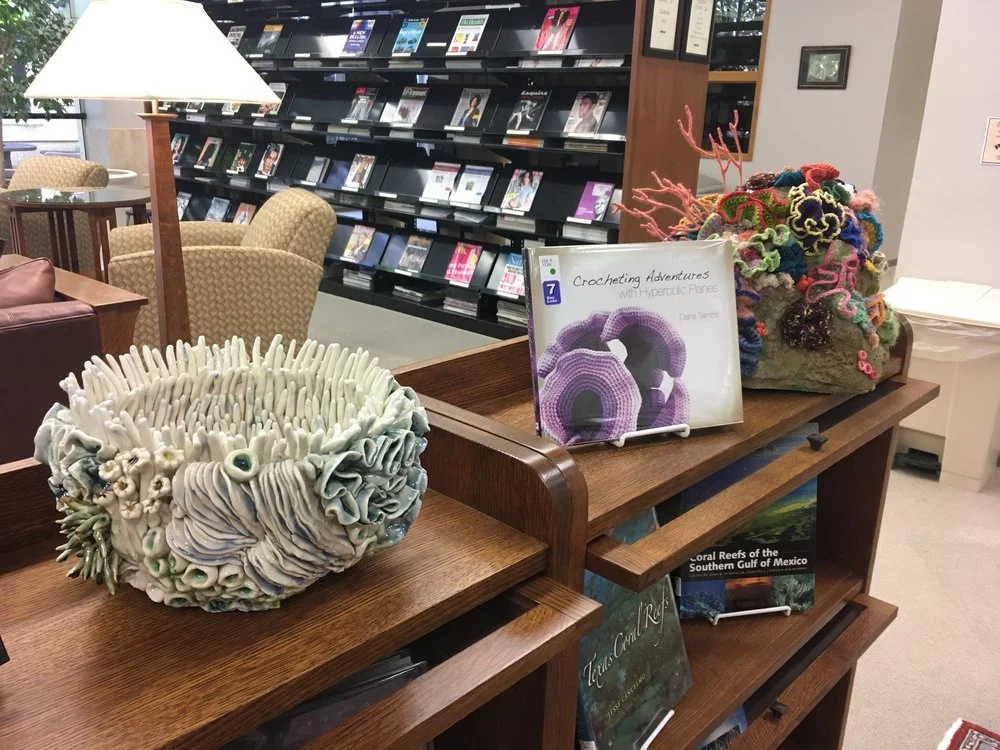2021 Hyperbolic Crochet exhibit
This exhibit brings together the creative effort of students, faculty and staff, many of whom just learned how to crochet, to understand how nature produces its beautiful structures. Naturally occurring shapes are irregular; they curve, ruffle and refuse to lie flat, in sharp contrast to man-made objects that adhere to the rules of classical Euclidean geometry with straight lines and recognizable polygonal shapes. Part of why many natural objects won’t lie flat is because they tend to expand as they grow outward, a feature of a non-Euclidean geometry called hyperbolic geometry. The medium of crochet turns out to be an excellent medium with which to embody this growth, to mimic the slow processes of coral formation, recreate the undulating shape of leaves, and imitate the spiraling ruffled legs of jellyfish.
It’s important to note that all of the artists in this exhibit are future, current and past natural science majors: mathematics, biology, computer science and physics. Just as there is a strong association between math, science and music, scientists and mathematicians are often drawn to crochet because of its patterns, its meditative quality, and the fact that one can create a cube, a sphere, hyperbolic surfaces or an adorable amigurumi plush toy with equal ease. It was a mathematician, Daina Taimina at Cornell University who first used the medium of crochet to create mathematical models of hyperbolic surfaces. Unlike the awkward paper models or flattened Poincare models that came before, her beautiful crocheted models allowed one to easily demonstrate the unique properties of hyperbolic planes, for example, that triangles in hyperbolic space have angles that add up to less than 180 degrees, or that one can have more than one line through a point that will never meet another line not going through that point. From there, an Australian science writer Margaret Wertheim recognized in the crocheted mathematical models the shape of corals in the Great Barrier Reef, and used this medium in exhibits at the Smithsonian and other venues around the world to draw attention to the coral bleaching events devastating the Reef. In this exhibit, we aim to show these hyperbolic structures are not only found in the ocean, but also found here in Georgetown, in house plants and lichen found covering live oak branches.
Contributors to the exhibit: Eileen Bishop ‘22, biology major; Emily Burns ‘22, computational math major; Lauren Calzado ‘23, mathematics major; Johnna Campbell ‘24, physics major; Fumiko Futamura, Professor of Mathematics; Aiko, 2nd grade, future STEM major; Dena Garcia, Library InfoDesk, computer science BA; Alley Koenig ‘24, mathematics major; Mel Richey ‘24, mathematics major; Angel Rodriguez ‘24, physics major; Katherine Samples ‘22, computer science major; Jenna Sandefur ‘23, biology major.
2018 Hyperbolic Crochet Coral Reef Project
This project began when I was asked if I could display a crochet coral reef at the March 2018 Hot Science Cool Talks event at UT Austin, in conjunction with a lecture on Texas' coral reefs. I agreed, and gave two talks, one for the 107 Lecture in the Math/CS department, and one for the SU Art Association. Both times, I not only taught students about hyperbolic geometry and how crochet is able to represent hyperbolic space as well as the growth patterns of certain corals, but also how to crochet. In the end, eleven students, faculty and a faculty spouse contributed to the coral reef project, which was displayed not only at the Hot Science Cool Talks event but also in the SU Smith Library during the last half of Spring 2018. The contributors are listed below.
Kari Darr ’20, Visiting Assistant Professor of Mathematics Linda DiLullo, Adina Friedman ’18, Associate Professor of Mathematics Fumiko Futamura, alumnus Christi Ho ’16, Abigail Jendrusch ’20, Jacob Jimerson ’20, Chris Nissen ’20, faculty spouse Elissa Schrum, Aiden Steinle ’20, Natalie Young ’20.


















